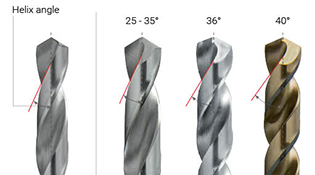Cobalt Titanium Nitride – DIN 338 Length

Type XGT-JN DIN 338 Length Cobalt Titanium Nitride 135° Split point
— Gyroidal torsion flute and wide land construction yields exceptional performance in deep hole drilling.
— Allows deep hole drilling without drill retraction.
— Titanium nitride coating for lubricity, abrasion resistance extended tool life.
— Recommended for a wide range of steels, castings and other hard metal drilling application.
— Proudly manufactured in the USA
with globally sourced material
 PDF — Type XGT-JN DIN 338 Length Cobalt Titanium Nitride
PDF — Type XGT-JN DIN 338 Length Cobalt Titanium Nitride

An essential feature of a twist drill is the helix angle (Spiral Angle). It determines the process
of chip formation. Larger helix angles provide effective removal of soft, long-chipping materials.
Smaller helix angles, on the other hand, are used for hard, short-chipping materials.
Twist drills that have a very small helix angle (10° - 19°) have a lengthy spiral. In return, twist drills with a large helix angle (27° - 45°) have a rammed (short) spiral. Twist drills with a normal spiral have a helix angle of 19° - 40°.
